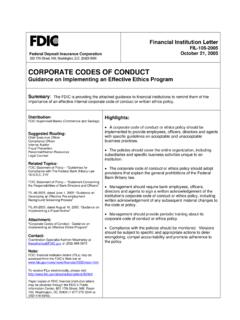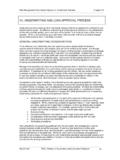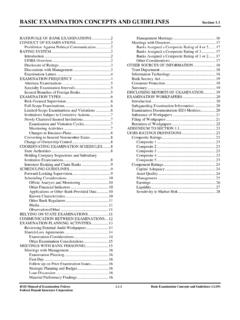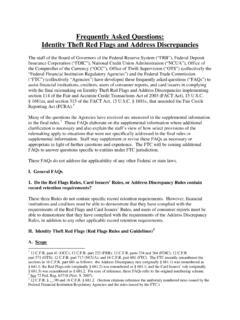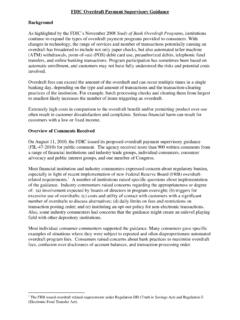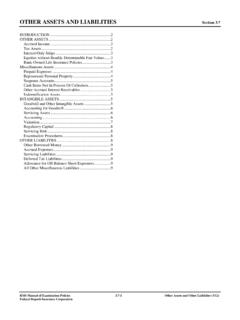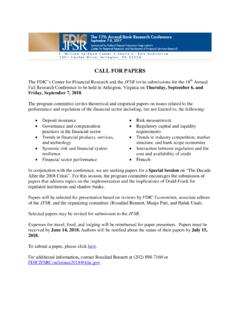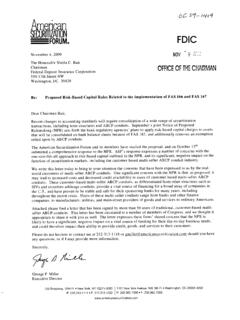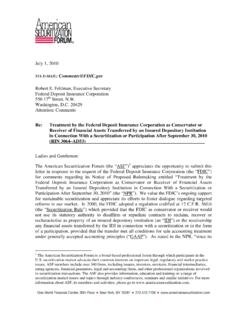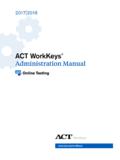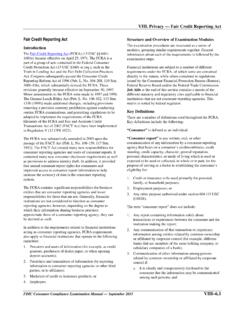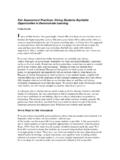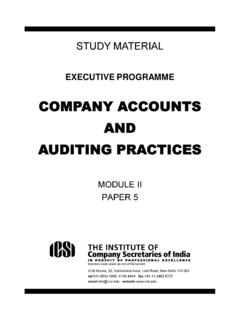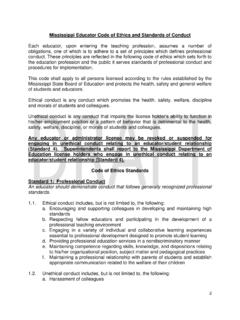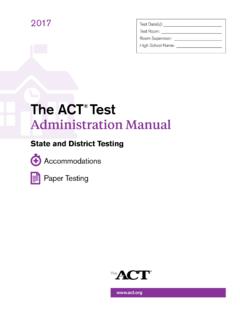Transcription of VII. Unfair and Deceptive Practices—Federal Trade ...
1 VII. Unfair and Deceptive practices Federal Trade Commission Act FDIC Consumer Compliance Examination Manual December 2018 VII Federal Trade Commission Act, Section 5 Unfair or Deceptive Acts or practices Introduction Advances in banking technology and changes in lending organization structure since Gramm-Leach-Bliley have permitted institutions to engage in non-banking activities and given banking organizations the ability to structure financial products in increasingly complex ways and to market such products with increasingly sophisticated methods. While most banking organizations do not engage in Unfair or Deceptive acts or practices (UDAPs), the pace and complexity of these advances heighten the potential risk for consumer harm. This potential risk, coupled with identified abusive practices , warrants increased scrutiny by the FDIC and state and federal enforcement agencies. UDAPs are illegal; can cause significant financial injury to consumers; erode consumer confidence; and present significant credit and asset quality risks, undermining the financial soundness of banking organizations.
2 Section 5 of the Federal Trade Commission Act (FTC Act) declares that UDAPs affecting commerce are illegal. See 15 USC 45(a) (Section 5 FTC Act). The banking agencies1 have authority to enforce Section 5 of the FTC Act for the institutions they supervise. The FDIC has provided notice to state nonmember institutions of its intent to cite them and their institution affiliated parties for violations of Section 5 FTC Act and of its intent to take appropriate action pursuant to its authority under Section 8 of the Federal Deposit Insurance Act (FDI Act) when a UDAP is discovered. The FTC has authority to take action against nonbanks that engage in a UDAP. If a UDAP involves an entity or entities over which more than one agency has enforcement authority such as, for example, the FDIC and the FTC, the agencies may coordinate their enforcement actions. Unlike many consumer protection laws, Section 5 of the FTC Act also applies to transactions with non-consumers and On March 11, 2004, the FDIC and the Board of Governors of the Federal Reserve System (FRB) issued additional guidance regarding UDAPs prohibited by Section 5 of the FTC Following the release of the guidance, the FDIC issued examination procedures include: Standards used to assess whether an act or practice is Unfair or Deceptive _____ 1 Federal Deposit Insurance Corporation, Federal Reserve Board, Office of the Comptroller of the Currency and Office of Thrift Supervision.
3 2 FTC v. IFC Credit Corp., 543 F. Supp. 2d 925, 943 (2008): The FTC has construed the term consumer to include businesses as well as individuals. Deference must be given to the interpretation of the agency charged by Congress with the statute s implementation. 3 See FIL-26-2004, Unfair or Deceptive Acts or practices Under Section 5 of the Federal Trade Commission Act (March 11, 2004). Interplay between the FTC Act and other consumer protection statutes Examination procedures for determining compliance with the FTC Act standards, including risk assessment procedures that should be followed to determine if transaction testing is warranted Best practices for documenting a case Corrective actions that should be considered for violations of Section 5 List of resources NOTE: In August 2014, the FDIC, FRB, CFPB, the National Credit Union Administration (NCUA), and the Office of the Comptroller of the Currency (OCC) (collectively, the Agencies) issued guidance regarding certain consumer credit practices as they relate to Section 5 of the FTC Act.
4 The authority to issue credit practices rules under Section 5 of the FTC Act ( , Regulation AA, Credit practices Rule) for banks, savings associations, and federal credit unions was repealed as a consequence of the Dodd-Frank Wall Street Reform and Consumer Protection Act (Dodd-Frank Act). Notwithstanding the repeal of such authority, the guidance indicated that the Agencies continue to have supervisory and enforcement authority regarding Unfair or Deceptive acts or practices , which could include those practices previously addressed in the former credit practices rules. Such practices included: (1) the use of certain provisions in consumer credit contracts, (2) the misrepresentation of the nature or extent of cosigner liability, and (3) the pyramiding of late fees. The guidance clarifies that institutions should not construe the repeal of these rules to indicate that the Unfair or Deceptive practices described in these former regulations are permissible.
5 The guidance makes clear that these practices remain subject to Section 5 of the Federal Trade Commission (FTC) Act and Sections 1031 and 1036 of the Dodd-Frank Act. Standards for Determining What is Unfair or Deceptive The legal standard for unfairness is independent of the legal standard for deception. Depending on the facts, an act or practice may be Unfair , Deceptive , both, or neither. In order to determine whether an act or practice is Unfair , the FDIC will consider whether the practice causes or is likely to cause substantial injury to consumers which cannot be reasonably avoided by consumers themselves and are not outweighed by countervailing benefits to consumers or to competition. 4 Section 5 of the FTC Act also applies to commercial transactions and businesses. In applying these statutory factors, the FDIC will identify and take action _____ 4 See FTC Policy Statement on Unfairness (December 19, 1980).
6 VII. Unfair and Deceptive practices Federal Trade Commission Act VII FDIC Consumer Compliance Examination Manual December 2018 whenever it finds conduct that is Unfair , as such conduct that falls well below the high standards of business practice expected of banks and the parties affiliated with them. To correct Deceptive Trade practices , the FDIC will take action against representations, omissions, or practices that are likely to mislead consumers acting reasonably under the circumstances, and are likely to cause such consumers harm. The FDIC will focus on material misrepresentations or omissions, that is, those that affect choices made by consumers because such misrepresentations are most likely to cause consumers financial UDAPs that violate the FTC Act may also violate other federal or state laws. However, practices that fully comply with consumer protection or other laws may still violate the FTC Act.
7 For additional information, please refer to the Relationship to Other Laws section further in this document. Unfair Acts or practices The FDIC applies the same standards as the FTC in determining whether an act or practice is Unfair . These standards were first stated in the FTC Policy Statement on Unfairness. Under the FTC Policy Statement on Unfairness, an act or practice is Unfair when it (1) causes or is likely to cause substantial injury (usually monetary) to consumers, (2) cannot be reasonably avoided by consumers, and (3) is not outweighed by countervailing benefits to consumers or to competition. Public policy may also be considered in the analysis of whether a particular act or practice is Unfair . All three of the elements necessary to establish unfairness are discussed further below. The act or practice must cause or be likely to cause substantial injury to consumers. Substantial injury usually involves monetary harm, but can also include reputational harm.
8 An act or practice that causes a small amount of harm to a large number of people may be deemed to cause substantial injury. An injury may be substantial if it raises significant risk of concrete harm. Trivial or merely speculative harms are typically insufficient for a finding of substantial injury. Emotional impact and other more subjective types of harm will not ordinarily make a practice Unfair . Consumers must not be reasonably able to avoid the injury. An act or practice is not considered Unfair if consumers may reasonably avoid injury. Consumers cannot reasonably avoid injury from an act or practice if it interferes with their ability to effectively make decisions or to take action to avoid injury. This may occur if _____ 5 See FTC Policy Statement on Deceptive Acts and practices (October 14, 1983). material information about a product, such as pricing, is modified or withheld until after the consumer has committed to purchasing the product, so that the consumer cannot reasonably avoid the injury.
9 It also may occur where testing reveals that disclosures do not effectively explain an act or practice to A practice may also be Unfair where consumers are subject to undue influence or are coerced into purchasing unwanted products or services. Because consumers should be able to survey the available alternatives, choose those that are most desirable, and avoid those that are inadequate or unsatisfactory, the question is whether an act or practice unreasonably impairs the consumer s ability to make an informed decision, not whether the consumer could have made a wiser decision. The FDIC will not second-guess the wisdom of particular consumer decisions. Instead, the FDIC will consider whether an institution s behavior unreasonably creates an obstacle that impairs the free exercise of consumer decision-making. The actions that a consumer is expected to take to avoid injury must be reasonable. While a consumer may avoid harm by hiring independent experts to test products in advance or bring legal claims for damages, these actions generally would be too expensive to be practical for individual consumers and, therefore, are not reasonable.
10 The injury must not be outweighed by countervailing benefits to consumers or to competition. To be Unfair , the act or practice must be injurious in its net effects that is, the injury must not be outweighed by any offsetting consumer or competitive benefits that are also produced by the act or practice. Offsetting consumer or competitive benefits may include lower prices or a wider availability of products and services. Nonetheless, both consumers and competition benefit from preventing Unfair acts or practices because prices are likely to better reflect actual transaction costs, and merchants who do not rely on Unfair acts or practices are no longer required to compete with those who do. Unfair acts or practices injure both consumers and competitors because consumers who would otherwise have selected a competitor s product are wrongly diverted by the Unfair act or practice. Costs that would be incurred for remedies or measures to prevent the injury are also taken into account in determining whether an act or practice is Unfair .
